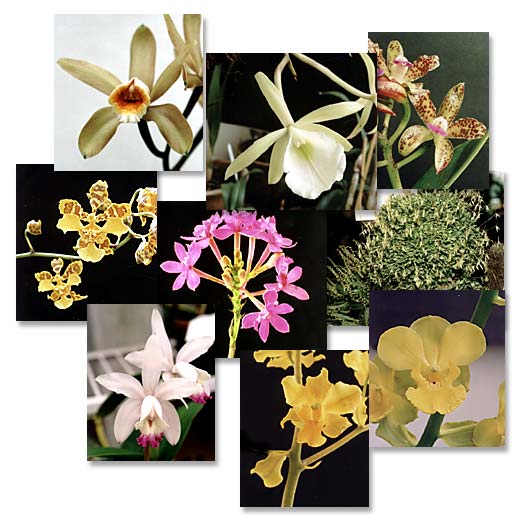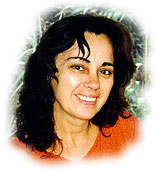

01
- Barbosella dusenii (A Sam.) Schltr.
02 - Bletia catenulata Ruiz e Pavón
03 - Brassavola flagellaris Barb. Rodr. (out of Massambaba restinga -
Massambaba Sandbank)
04 - Brassavola tuberculata Hook.
05 - Campylocentrum micranthum (Lindl.) Rolfe
06 - Campylocentrum robustum Cogn.
07 - Campylocentrum spannagelli Hoehne
08 - Catasetum discolor Lindl.
09 - Catasetum discolor Lindl. var. fimbriatum (Rchb. f. ) Hoehne
(Jacarepaguá) (Catasetum gardneri Schltr.)
10 - Cattleya forbesii Lindl. (towards the south of the state of RJ,
out of Massambamba Restinga)
11 - Cattleya guttata Lindl. (also present in many sandbanks of the state)
12 - Cattleya intermedia Graham ex Hooker
13 - Cyclopogon variegatus Barb. Rodr. (out of Massambamba Restinga)
14 - Cyrtopodium dito andersonii R. Br. (out of Massambamba)
15 - Cyrtopodium polyphyllum (Vell.) Pabst ex F. Barros (Cyrtopodium
paranaense Schltr.) (out of Massambamba)
16 - Eletroplectris calcarata (Sw.) Goray & Sweet (Out of Massambamba)
17 - Eletroplectris triloba (Lindl.) Pabst
18 - Encyclia oncidioides (Lindl.) Schltr.
19 - Epidendrum denticulatum Barb. Rodr. (also present in many sandbanks
of the state)
20 - Epidendrum difforme Jacq. out of Massambamba)
21 - Epidendrum ellipticum Grah. (out of Massambamba, present in many
sandbanks of the state)
22 - Epidendrum huebneri Schltr. (out of Massambamba)
23 - Habenaria gnoma Barb. Rodr. (out of Massambamba)
24 - Habenaria josephensis Barb. Rodr. (Cabo Frio and some other sandbanks)
25 - Habenaria leptoceras Hook. (Habenaria armondiana Hoehne) (Cabo Frio
and some other sandbanks)
26 - Habenaria parviflora Lindl. (Cabo Frio and some other sandbanks)
27 - Habenaria repens Nutt. (Habenaria taubertiana Cogn.)
28 - Masdevallia sp. (Out of Massambamba)
29 - Oeceoclades maculata (Lindl.) Lindl.
30 - Oncidium barbatum Lindl. (out of Massambamba)
31 - Pleurothallis saundersiana Rchb. f.
32 - Pleurothallis cf. trifida Lindl.
33 - Prescottia densiflora Lindl. (Cabo Frio)
34 - Prescottia oligantha (Sw.) Lindl. (Prescottia micrantha Lindl.)
35 - Prescottia plantaginea Lindl. (out of Massambamba)
36 - Stenorrynchus hassleri Cogn.
37 - Vanilla chamissonis Kl. var. brevifolia Cogn. also present
in many sandbanks of the state)
According
to Dorothy S. Dunn de Araujo and Raimundo P. B. Henriques, in "Análise
Florística das Restingas do Estado do Rio de Janeiro" (Floristic
Analyse of the Sandbanks of the State of Rio de Janeiro) (published in l984),
the following species of Orchidaceae family grow in the restingas (sandbanks)
of the state of Rio de Janeiro (Cabo Frio, Araruama, Maricá, Itaipu,
Jacarepaguá, Grumari and Marambaia):
Dorothy
Sue Dunn de Araujo, ecologist, whose doctorate thesis is entitled "Análise
florística e fitogeográfica das restingas do Estado do Rio de
Janeiro" (Floristic and Phyto-geographic Analyse of the Sand-banks of the
State of Rio de Janeiro de Janeiro), based on her own researches in field, in
herbariums and bibliography, confirmed the occurrence in the restingas of the
state of Rio Janeiro which were not included in the list above. We can also
verify the disappearance of some others (list updated in September 2001)
This work is presented in the Restinga Net - http://www.restinga.net
This site has the collaboration of 121 researchers in Botany, Ecology, Zoology, Conservation, Geoscience,
etc

01 - Aspidogyne argentea (Vell.) Garay
02 - Aspidogyne kuczynskii (Porsch) Garay
03 - Campylocentrum densiflorum Cogn.
04 - Campylocentrum wawrae (Rchb. f. ex Beck) Rolfe
05 - Catasetum luridum (Link) Lindl.
06 - Cattleya harrisoniana Bateman
07 - Dryadella obrieniana (Rolfe) Luer
08 - Epidendrum fulgens Brongn.
09 - Epidendrum rigidum Jacq.
10 - Liparis elata Lindl.
11 - Malaxis histionantha (Link, Klotzsch & Otto) Garay & Dunst.
12 - Maxillaria brasiliensis Brieger & Bicalho
13 - Maxillaria rufescens Lindl.
14 - Notylia pubescens Lindl.
15 - Octomeria grandiflora Lindl.
16 - Oncidium ciliatum Lindl.
17 - Pleurothallis cf. bradei Schltr.
18 - Pleurothallis migueliana Lindl.
19 - Pleurothallis ramphastorhyncha (Barb. Rodr.) Cogn.
20 - Polystachya aff. concreta (Jacq.) Garay & H. R. Sweet
21 - Prescottia stachyoides (Sw.) Lindl.
22 - Rodriguezia sucrei Braga
23 - Sacoila lanceolata (Aubl.) Garay
24 - Vanilla bahiana Hoehne

01 - Brassavola flagellaris Barb. Rodr.
02 - Campylocentrum robustum Cogn.
03 - Campylocentrum spannagelli Hoehne
04 - Catasetum discolor Lindl. var. fimbriatum (Rchb. f. ) Hoehne (Catasetum
gardneri Schltr.)
05 - Cyrtopodium dito andersonii R. Br.
06 - Epidendrum ellipticum Grah.
07 - Habenaria gnoma Barb. Rodr.
08 - Habenaria josephensis Barb. Rodr.
09 - Masdevallia sp.
10 - Oeceoclades maculata (Lindl.) Lindl.
11 - Oncidium barbatum Lindl.
12 - Prescottia densiflora Lindl.
13 - Stenorrynchus hassleri Cogn.
In
the research (published in 1993), done in Massambaba restinga, Maria da Penha
Fagnani and Carlos Ivan Siqueira found the following species:
01
- Bletia catelunalata Ruiz et Pavón
02 - Brassavola tuberculata Hook (Brassavola perrinii Lindl. )
03 - Campylocentrum selowii
04 - Campylocentrum robustum Cogn
05 - Catasetum discolor Lindl.
06 - Cattleya guttata Lindl.
07 - Cattleya intermedia Grah.
08 - Cyrtopodium polyphyllum (Vell.) Pabst ex F. Barros (Cyrtopodium
paranaensis Schltr.)
09 - Eletroplectris triloba (Lindl) Pabst
10 - Encyclia oncidioides Schltr.
11 - Epidendrum denticulatum Barb. Rodr.
12 - Epidendrum huebneri Schltr.
13 - Epidendrum x ormindoi Miranda
14 - Habenaria parviflora Lindl.
15 - Habenaria taubertiana Cogn.
16 - Oncidium ciliatum Lindl.
17 - Pleurothallis sp
18 - Prescottia oligantha (Sw.) Lindl. (Prescottia micrantha Lindl.)
19 - Vanilla planifolia Andr.
20 - Vanilla chamissonis Klotszch.

The restingas (Sandbanks) are located in the coastal plains which are formations originated by sediments due to different factors, mainly the oscillations of the sea level and the climatic changes. Those sediments have many forms and one of them is called "coastal cord", formed by maritime sediments (constant depositions of sands) originating bunches of sandbanks showing the progressive rise and the fall in the level of the sea. They are recent geological formations, submitted to the continental and marine actions.
In the state of Rio de Janeiro, those cords start since Itabapoana (in the boundary of the state of Espírito Santo) until the Trindade beach, going across Macaé, lakes region (Arraial do Cabo, Cabo Frio, Araruama) and Rio de Janeiro city, since the north until the south of the state. Some
of those restingas are well known such as Massambaba restinga which separates
Araruama lagoon from the sea and Marambaia restinga (45km. lenght), as it is
occupied by the Army, the access is more restrict, thus it is quite preserved.
It is consisted by narrow and discontinued strips with very fine white sand,
covered by a sparse vegetation, crawling herbs and few shrub. The soil has a
high-grade of salinity
Marapendi
area (in Rio de Janeiro city) has loose the characteristic by the drawing of
Sernambetiba avenue. The restingas former existing in the quarters of Botafogo,
Governador Island, Copacabana, Ipanema, Leblon and a great part of Barra da
Tijuca and lowlands of Jacarepaguá have been destroyed by the expansion
of habitations.

The origin of the lagoons is related to the formation of those coastal cords.
The coastal cord known as Massambaba restinga with 50km long originated Araruama
lagoon.
On the other hand, Marambaia restinga, with 40 km long de originated the bay of Sepetiba.
In the edges of those lagoons or bay, the sediments originated by the action
of the fluxes of the water that go down from the neighbouring mountains.
The vegetation of restingas is called pioneer formations (as well as those from the mangrove, beaches and dunes).
This is a vegetation of first occupation in a area where the soils are continually submitted to the maritime, fluvial and fluvial-marine influences (arboreous and herbaceous vegetation).
The
vegetation is not regular and is presented in bushes shape, under the form of
sparse fields of grass, dense woods with 12m height or swamps areas. There are
the external sandy cord or external sandbank (next to the sea), internal sandy
cord or internal sandbank, next to the lagoon and between both, there is a swampy
area, covered with dense organic material. Except to the swampy area, the soil
does not retain the humidity because it is very sandy, not being in this way
the mainly source of nutrients.

The restingas are, in general, little exposed to rains and are hit by the wind that blows daily and the ocean (in this case, the Atlantic) exercises an important role of thermal regulator with a strong power of elevating the humidity of the air.
The two mainly restingas of the state of Rio de Janeiro have a great difference:
Massambaba restinga is, in the bigger part, located in area with demi-humid regime from 4 to 6 dry months, a small fraction in dry regime (from 7 to 10 dry months) and extremely dry (from 11 to 12 dry months).
On the other hand, Marambaia restinga in a area of very humid regime (no dry month) and humid (from 1 to 3 dry months).
Both are situated in a thermal regime considered hot, it means, they do not present an average temperature during the coldest days, above 18º
C.
Those factors determine the specialisation of the vegetation making it tolerates
the strong drought periods or excessive humidity.

Some areas are under protection of the Government (Federal, of the municipality or the State) as unity of conservation, nevertheless, they endure the same problems the others non-protected areas. In all of them, the mainly problems involve the pollution of the water by the domestic sewerage systems, illegal extraction of sand and plants, degradation of areas reserved to preservation and archaeological sites, irregular and illegal occupation of the strip of the lagoon shore, deforestation and burning, illegal hunting, the accumulation of any kind of refuse, degradation of the vegetation by the jeeps and other vehicles of vacationists mainly during the high season.
All information has been done just for curiosity, with the purpose of helping to understand a little more about the habitat of those species.
Bibliography:
- Território - Estado do Rio de Janeiro - Governo do Estado do Rio
de Janeiro - Secretaria de Estado de Planejamento e Controle
- SECPLAN - Cide - Centro de Informações e Dados do Rio de Janeiro
- edição 1997.
- Revista Orquidário, volume 6, nº 2, abril-maio-junho l992 páginas
51 a 54 - Orquídeas da Restinga de Massabamba, Maria
da Penha K. Fagnani e Carlos Ivan da Silva Siqueira.
- Revista Orquidário, volume 7, nº2, abril-junho l993 páginas
591 a 62 - Orquídeas da Restinga de Massabamba II, Maria
da Penha K. Fagnani e Carlos Ivan da Silva Siqueira.
- Revista Orquidário, volume 12, n° 4, Eltroplectris triloba ,
uma espécie pouco conhecida, por Maria da Penha K. Fagnani,
Sylvio Rodrigues Pereira e Dulce Nascimento.
- Boletim Caob, ano V, volume V, n° 3, out/dez. 93, Lou Menezes, Bletia
catenulata, var. coerulea.
- Revista Ciência Hoje, Vol. 6, nº33, julho de l987. páginas
41-58.
- Iconografia de Orchidaceas do Brasil, F.C. Hoehne, Secretaria de Agricultura
- São Paulo - Brasil.
- Orquídeas do Alto da Serra da Mata Atlântica Pluvial do Sudeste
do Brasil, David Miller e Richard Warren.
- Araujo, D. & Henriques R. l984, Análise Florística das
Restingas do Estado do Rio de Janeiro. in: Lacerda, L. D. et al.
- Restingas: origem, estrutura e processos, Niterói, CEUFF, Rio de
Janeiro, 477 p.
Credits:
Photos by: Carlos
Ivan Siqueira, Maria da Penha Fagnani,
Sergio Araujo and Sylvio R. Pereira
It's
expressly forbidden any kind of use of any material from
this site (text, photo, images,design, layouts and others)
without the express authorization of the authors
Carlos
Ivan Siqueira: cis@oglobo.com.br
Maria da Penha Fagnani: bo@sergioaraujo.com
Sergio Araujo: sergioaraujo@pobox.com
Sylvio R. Pereira:orquidario@orquidario.com.br
 back to the summary
back to the summary



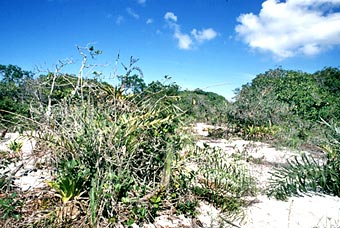
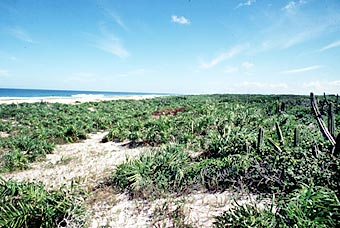
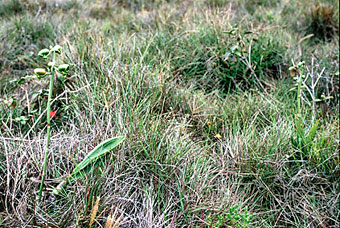
![]()
